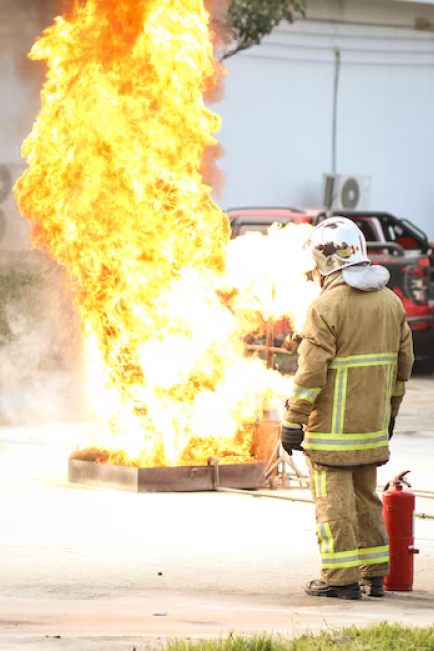Fire Safety Training: Enhancing Workplace Safety Through Essential Skills and Practices
- info@safetymastery.com
- +91 7200322134


Key Elements of Fire Safety Training for Effective Workplace Fire Prevention
Key Elements of Fire Safety Training for Effective Workplace Fire Prevention
Fire safety training is a critical component of workplace safety, equipping individuals with the knowledge, skills, and confidence to prevent fires, respond to emergencies, and protect lives and property. By investing in comprehensive fire safety training programs, organizations can create a safer work environment, reduce the risk of fire incidents, and ensure that employees are prepared to handle fire emergencies effectively. In this comprehensive guide, we explore the importance of fire safety training, essential skills and practices for workplace fire prevention, and the benefits of effective fire safety management.

Safety International Diploma
- Ofqual Regulated Qualifications London, UK
- GradIOSH/CertIOSH status from IOSH, UK
- TSP status from BCSP, USA
- Gateway to MSC in UK universities
one or two years of qualification.
Get Courses Details
Get Courses Details
Safety Diploma
- Government-Endorsed National Safety Diploma Program
- Qualify for registration at the Employment Exchange
- Attestation by the Ministry of External Affairs for those wishing to move abroad
- Eligible for membership with MIIRSM (IIRSM membership at discretion)
- Approved by the Government of India
- Enhance your educational profile with an additional one or two years of qualification
Importance of Fire Safety Training:
- Prevention of Fire Incidents: Fire safety training helps individuals identify fire hazards, implement preventive measures, and adhere to safety protocols to reduce the risk of fire incidents in the workplace.
- Emergency Response Preparedness: By providing fire safety training, organizations ensure that employees are prepared to respond quickly and effectively in the event of a fire emergency, minimizing injuries, property damage, and disruptions.
- Compliance with Regulations: Adherence to fire safety training requirements, regulations, and standards is essential for ensuring legal compliance, meeting industry guidelines, and promoting a safe work environment.
- Employee Well-being: Fire safety training prioritizes the well-being and safety of employees, empowering them with the knowledge and skills to protect themselves, their colleagues, and the workplace from fire hazards.
Property Protection: Effective fire safety training not only safeguards lives but also helps protect valuable assets, equipment, and property from fire damage, reducing financial losses and business interruptions.

Key Skills and Practices for Fire Safety Training:
- Fire Prevention Techniques: Educate individuals on fire prevention strategies, housekeeping practices, electrical safety, smoking policies, and proper storage of flammable materials to reduce fire hazards in the workplace.
Emergency Procedures: Train employees on emergency response protocols, evacuation routes, assembly points, alarm systems, and the use of fire extinguishers to ensure a swift and coordinated response to fire emergencies.
Fire Extinguisher Use: Provide hands-on training on the types of fire extinguishers, their operation, the PASS technique (Pull, Aim, Squeeze, Sweep), and the appropriate extinguisher for different types of fires (e.g., Class A, B, C).
Evacuation Drills: Conduct regular fire drills, evacuation exercises, and simulations to practice emergency response, test evacuation procedures, and familiarize employees with evacuation routes and safety protocols.
Smoke Detection and Alarms: Educate individuals on the importance of smoke detectors, fire alarms, and alert systems, and instruct them on how to respond to alarm signals, evacuate safely, and avoid smoke inhalation during a fire.

Benefits of Effective Fire Safety Training:
Reduced Risk of Fire Incidents: By providing comprehensive fire safety training, organizations can reduce the risk of fire incidents, prevent accidents, and protect lives and property in the workplace.
- Quick and Effective Response: Well-trained employees can respond quickly and effectively to fire emergencies, evacuate safely, and use fire safety equipment properly to contain and extinguish fires before they escalate.
Compliance and Legal Protection: Adherence to fire safety training requirements, regulations, and standards ensures legal compliance, reduces liability, and protects organizations from penalties related to safety violations.
Improved Safety Culture: Fire safety training fosters a culture of safety, awareness, and preparedness among employees, encouraging active participation in safety programs, hazard reporting, and emergency response.
Property Protection: Effective fire safety training not only safeguards lives but also helps protect valuable assets, equipment, and property from fire damage, minimizing financial losses and business disruptions.

Benefits of Effective Fire Safety Training:
- Communication and Coordination: Establish clear communication channels, emergency notification systems, and protocols for reporting fires, raising alarms, and coordinating response efforts with designated fire marshals or emergency response teams.
- Safety Equipment Checks: Instruct individuals on how to check and maintain safety equipment, such as fire extinguishers, fire alarms, emergency lighting, sprinkler systems, and smoke detectors, to ensure they are in working condition.
Fire Safety Inspections: Conduct regular fire safety inspections, audits, and assessments of the workplace to identify fire hazards, assess risks, and implement corrective actions to address unsafe conditions and prevent fire incidents.
Fire Marshal Training: Designate and train fire marshals, safety wardens, or emergency response teams to take on leadership roles during fire emergencies, coordinate evacuation procedures, and communicate with emergency services.
Post-Fire Procedures: Educate individuals on post-fire procedures, such as damage assessment, safety inspections, equipment checks, debriefing sessions, and follow-up actions to review fire incidents, identify lessons learned, and improve fire safety practices.

Fire safety training is a fundamental aspect of workplace safety, empowering individuals with the knowledge, skills, and confidence to prevent fires, respond to emergencies, and protect lives and property in the event of a fire incident. By investing in effective fire safety training programs, organizations can create a safer work environment, reduce the risk of fire incidents, and ensure that employees are prepared to handle fire emergencies with competence and readiness. Remember: fire safety training is not just a requirement—it is a commitment to protecting the well-being of individuals, promoting a safe work environment, and preventing fire incidents through proactive education and preparedness.
